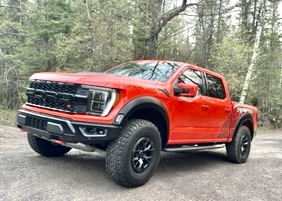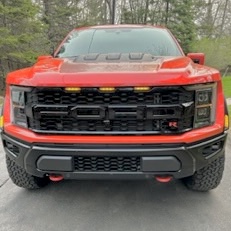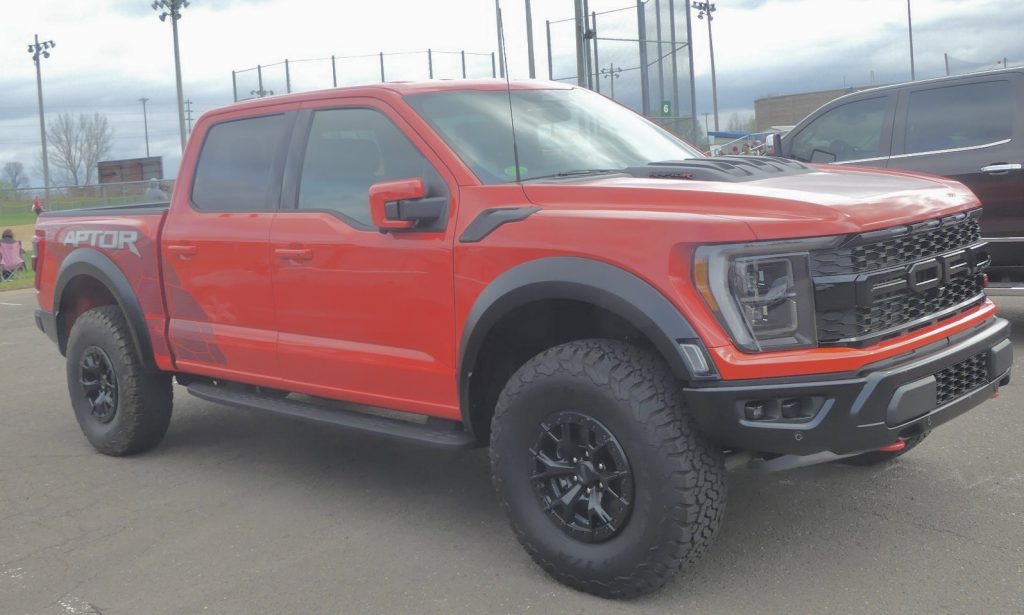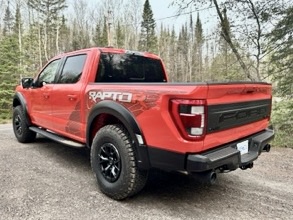New Raptor R whistles with high-tech muscle

The new Ford Raptor R becomes king of the large-pickup hill with a high-tech 700 horsepower V8 out of the Mustang GT500.
By John Gilbert
There will never be another time when those of us in the business of reviewing new vehicles will have the sheer excitement of those days back about 1970, when factories competed with each other to build the most potent muscle cars to race each other in events like the Trans-Am road-racing series.
Back then, you could go to a showroom and select a Ford Mustang, Chevrolet Camaro, Dodge Challenger, Plymouth Barracuda, Pontiac Firebird, or American Motors Javelin, and approximate the thrills great drivers like Parnelli Jones, Mark Donohue, Dan Gurney, Swede Savage, Sam Posey and others gave us — and themselves — to battle for supremacy.
As a young reporter recently married and with a young son named Jack, we compared all of them for my road-test reviews in the Minneapolis Tribune, and decided to purchase a 1970 Mustang Boss 302, which had a specially-built 5-liter V8 that had solid valve lifters, a forged steel crankshaft instead of cast iron, and was the closest thing to a race engine in a stock, street vehicle. That 1970 Boss 302 was extremely quick, handled with instant precision and revved to over 6,000 RPMs. It also emitted a low roar that built until converting to a high-pitched whistle as you neared the red line.
The only place you can find contemporary manufacturers’ competition for all-out performance nowadays has transferred to pickup trucks, which shouldn’t be surprising, because pickups are the ultimate pure-American vehicle, and the top models from Ford, Chevrolet, Ram, Toyota and Nissan are trying every year to outdo each other to build the baddest, most imposing pickups on the planet.
For several years, Ford built a specialty off-road F-150 that started with a unique widened and toughened new frame for the best stability in the pickup world, and after adding all sorts of ultimate off-road features to upgrade its suspension, terrain-clearance, shock travel to climb the toughest terrain, and anything else imaginable, they named it the Raptor.
It also came with a reinforced 3.5-liter, dual-overhead cam V6 that was turbocharged to EcoBoost standards, and it was declared king of the hill(s). For $78,545, you could rule the roads, and the off-roads.
But then a couple years ago, Dodge sent its Ram division engineers off to build a more powerful rival to the Raptor, and with proper marketing flair designated the new Ram entry the TRX. Fitted with the monster 6.2-liter Hemi V8 out of the Charger/Challenger Hellcat models, the TRX developed 702 supercharged horsepower, which left the Raptor in its rear-view mirrors with “only” 450 horses.
Never mind that the Raptor still had a clear edge in refinement, comfort and compliance, the TRX gained the nickname “Tyrannosaurus Rex,” shortened to “T-Rex” by muscle-car zealots, perhaps unaware of the irony of what may be a dying breed of overpowering hot-rods.

Active shutters aid air intake on the blacked-out Raptor R grille, with all its outlining accessory lights.
Regardless, the new challenge was not to be ignored by Ford, realizing the TRX could whip the Raptor by nearly a half-second from 0-60, registering 4.1 seconds in several tests.
Ford engineers went back to the drawing board, selecting the high-tech 5.2-liter dual-overhead-cam V8 they had built for the new Mustang GT500, and supercharging it up to 700 horsepower. That sounded like a near-miss, compared to the Ram’s 702 horses, but the Ford is significantly lighter, and, sure enough, the Raptor R now can beat the monster TRX by about 0.4 seconds from 0-60. Motor Trend listed the Raptor R’s 0-60 sprint at 3.7 seconds. It was a solid corporate victory against a Dodge power plant that appears to have reached its saturation point.
With 640 foot-pounds of torque backing its 700 horsepower, the Raptor R can scale cliffs in record time through its 10-speed automatic transmission, and those rocky terrain chunks it doesn’t clear will be pulverized by the heavy-duty skid-plates mounted under the raised body. The 700 horsepower peaks at 6,650 RPMs, while the stump-pulling torque needs only 4,050 revs to hit that peak.
For other dimensions, the Raptor R weights 5,960 pounds, with a length of 232.6 inches and a wheelbase of 145.4 inches. Its height is 80.6 inches, and its width is 87 inches. The width means you pretty well fill your driving lane, as well as ay parking spots you may find, but the height is another factor for drivers and passengers, because while it might be easy for a high jumper or pole vaulter, it is greatly aided by a lightweight but strong aluminum running board, finished in a pebbley black material not unlike the spray-in bedliner stuff to prevent slipping when winter brings ice and packed snow onto that running board.
Once inside, the black leather Recaro bucket seats are fantastic, cementing you in place if you’re bouncing around avoiding potholes or tackling Moab, or for just supportive comfort on a trip or for daily driving.
The sticker price is sticky, because all those heavy-duty features are after-market parts are blended with the contemporary safety devices to keep you in your lane and alert you to exterior vehicles and people and the price rises from the test vehicle’s base price of $109,145 to an as-tested price of $109,760.
That includes all the features, and the flashy Code Orange Metallic paint scheme with its black graphic package, and the blackened grille with its active shutter system.
If the price puts it out of your price range — maybe far, far out of your price range — consider that you’re paying a little extra for the imposing look of the Raptor R and for obtaining the baddest pickup truck in your neighborhood.

With all the impressive features of the super-wide Raptor R, there is also that high-pitched — and programmable — engine sound.
And here’s an extra inducement: When you start up from a stop and have only a small opening to enter the freeway, you hit the gas pedal hard and you can be treated to one of four selectable exhaust sounds, up to and including the “Sport” setting, which, I swear, goes from a hearty roar as you rev it up to 6,000 revs where it changes into what can only be described as a 1970 Boss 302 whistle!
The only thing better than muscle-car muscle is high-tech muscle-car muiscle.





 John Gilbert is a lifetime Minnesotan and career journalist, specializing in cars and sports during and since spending 30 years at the Minneapolis Tribune, now the Star Tribune. More recently, he has continued translating the high-tech world of autos and sharing his passionate insights as a freelance writer/photographer/broadcaster. A member of the prestigious North American Car and Truck of the Year jury since 1993. John can be heard Monday-Friday from 9-11am on 610 KDAL(www.kdal610.com) on the "John Gilbert Show," and writes a column in the Duluth Reader.
John Gilbert is a lifetime Minnesotan and career journalist, specializing in cars and sports during and since spending 30 years at the Minneapolis Tribune, now the Star Tribune. More recently, he has continued translating the high-tech world of autos and sharing his passionate insights as a freelance writer/photographer/broadcaster. A member of the prestigious North American Car and Truck of the Year jury since 1993. John can be heard Monday-Friday from 9-11am on 610 KDAL(www.kdal610.com) on the "John Gilbert Show," and writes a column in the Duluth Reader.